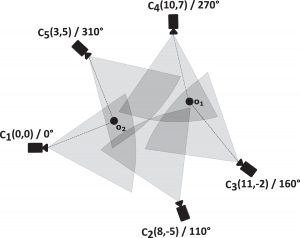Smart camera networks are real-time distributed embedded systems that perform computer vision using multiple cameras. They have emerged thanks to the simultaneous advances in four key disciplines: computer vision, image sensors, embedded computing, and sensor networks.
“We aim at advancing this field of research by applying novel networking concepts as well as by developing various prototypes,” Bernhard Rinner explains. Analyzing the captured data within the network in real-time is important to avoid transferring large volume of video data over the network. The strong resource limitations are challenging and require efficient algorithms and network management. The research team has developed various camera platforms and has deployed several camera networks both in indoor and outdoor environments. Prototype installations include traffic monitoring, environmental monitoring, and surveillance.
In-network processing is concerned about the management of the available resources in the camera network. Examples of such resource management include clustering, i.e., selecting a group of cameras which jointly work a specific task, handover, i.e., transfering a specific task from one camera to another, and calibration, i.e., estimating the spatial relationship among the individual cameras.

In her recent work, Jennifer Simonjan developed a decentralized and resource-aware algorithm for estimating the poses of all camera nodes without any user interaction. “Self-calibration is achieved in two steps,” she explains. “First, overlapping camera pairs estimate relative positions and orientations by exchanging locally measured distances and angles to detected objects. Second, calibration information of overlapping cameras is spread throughout the network such that poses of non-overlapping cameras can also be estimated.”
Bernhard Rinner and his team have been involved in smart camera research for more than a decade. The following articles document some highlights of that period:
- A short history of smart cameras — a personal perspective
- Relauch of the SmartCam site @ TUGraz (now smartcam.bernhardrinner.com) (watch out for our first videos!)
- Co-initiation of the ACM/IEEE International Conference on Distributed Smart Cameras (11th edition in 2017)
- Co-editing (with W. Wolf) of a special issue on Distributed Smart Cameras in the Proceedings of the IEEE
- Held various tutorial talks – recently on Smart Cameras and Visual Sensor Networks at the S5 spring school in Modena
- Co-editing (with M. Reisslein and A. Roy-Chowdhury) of a special issue on Smart Camera Networks in IEEE Computer
Selected Publications
J. Simonjan and B. Rinner. Decentralized and Resource-efficient Self-Calibration of Visual Sensor Networks. Ad Hoc Networks, 2019.
C. Piciarelli, L. Esterle, A. Khan, B. Rinner, and G. L. Foresti. Dynamic reconfiguration in camera networks: A short survey. IEEE Transactions on Circuits and Systems for Video Technology, 2016.
B. Rinner, L. Esterle, J. Simonjan, G. Nebehay, R. Pflugfelder, P. R. Lewis, and G. F. Dominguez. Self-aware and self-expressive camera networks. IEEE Computer, 2015.
C. Micheloni, B. Rinner, and G. L. Foresti. Video analysis in PTZ camera networks: From master-slave to cooperative smart cameras. IEEE Signal Processing Magazine, 2010.
B. Rinner and W. Wolf. Introduction to distributed smart cameras. In Proc. IEEE, 2008.
M. Bramberger, A. Doblander, A. Maier, B. Rinner, and H. Schwabach. Distributed embedded smart cameras for surveillance applications. IEEE Computer, 2006.
